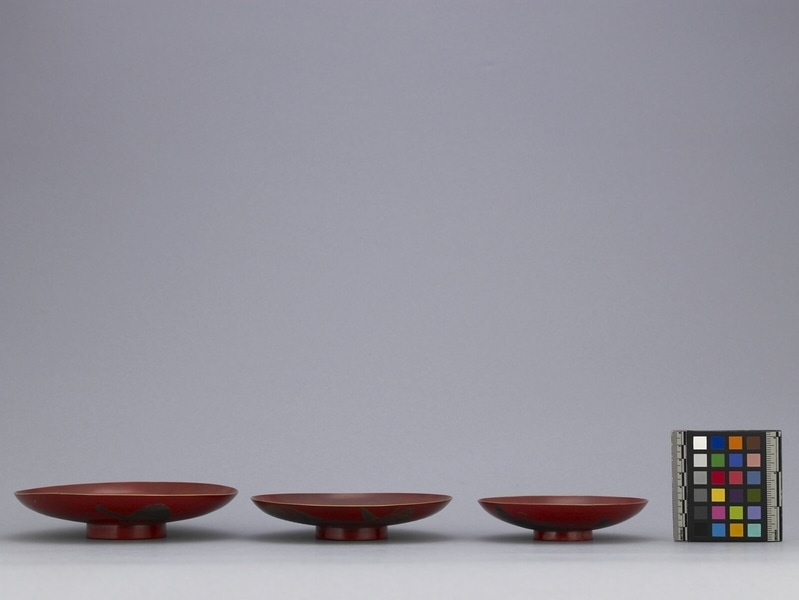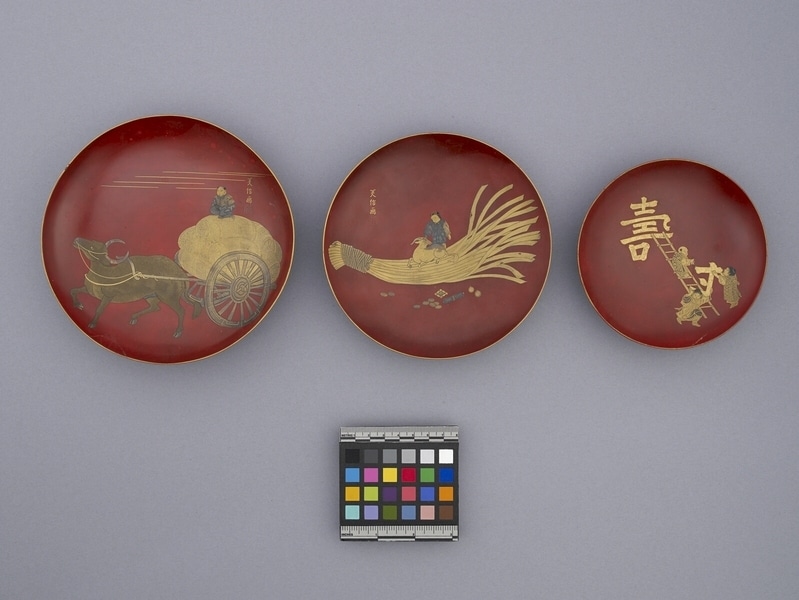Sake Cup Item Number: N2.942 a-c from the MOA: University of British Columbia




Description
Three red lacquer shallow, footed, sake cups known as sakazuki (盃), each with an image in gold, metallic brown, and black. Part a is the largest and has an image of a man riding on top of a cart of barrels being pulled by a bull; part b is slightly smaller with an image of a person with their hand on a goat's head, superimposed on rice straws with objects below them; part c is the smallest cup with an image of two figures holding a gold Japanese character, sun (寸) and another figure on a ladder that leads up to a large gold Japanese character, kotobuki (寿). The two large cups have a signature, 美信画 (Yoshinobu-ga; picture by Yoshinobu).
History Of Use
Shallow, footed sake cups known as sakazuki (盃) are used for ceremonies. They are often made from wood with a lacquer finish but are sometimes made from metal. A set of three red lacquer sakazuki like this set is often used in a binding ritual, called san san kudo (三々九度), literally meaning “three, three, nine times” in a Shintō wedding ceremony. The smallest sakazuki represents a couple’s past and their gratitude for their ancestors; the mid-sized cup represents their present and their determination to live together; the largest represents their future and the family’s prosperity.
Narrative
The work is signed 美信画 (Yoshinobu-ga), and might be modelled after or inspired by the works by Kano Yoshinobu (狩野美信; 1747-1797), also known as Kano Tōshun Yoshinobu (狩野洞春美信), or possibly attributed to him as he did produce lacquer works. [It is unlikely by Komai Yoshinobu (駒井美信), who was active c. 1765–1770.]
Item History
- Made by Yoshinobu Kano ? (Maker) in Japan during 1849
- Owned by Mary E. Lipsett before June 15, 1949
- Received from Mary E. Lipsett (Donor) on June 15, 1949
What
Who
- Culture
- Japanese
- Creator
- Yoshinobu Kano ? (Maker)
- Previous Owner
- Mary E. Lipsett
- Received from
- Mary E. Lipsett (Donor)
Where
- Holding Institution
- MOA: University of British Columbia
- Made in
- Japan
When
- Creation Date
- during 1849
- Ownership Date
- before June 15, 1949
- Acquisition Date
- on June 15, 1949
Other
- Condition
- good
- Current Location
- Case 79
- Accession Number
- 2282/0024 a-c